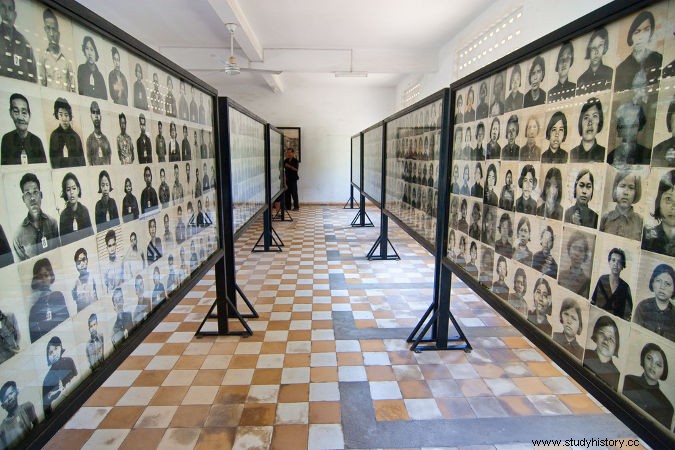
Pol Pot was leader of the Communist Party of Cambodia, the Khmer Red . In addition, he controlled that country during a period of almost four years in which he imposed a dictatorial rule that resulted in the deaths of 1.5 million people, most of them as a result of famine. Pol Pot's dictatorial policy became known as the Cambodian genocide.
Pol Pot's Youth
Pol Pot was born under the name of Saloth Sar in a fishing village called Prek Sbauk, in French Indochina (a region where present-day Cambodia is located), on May 19, 1925. His family had a very good living condition compared to the vast majority of Cambodians. This was largely due to the fact that his family had a connection to the Cambodian royal family. Furthermore, his parents owned a large rice producing farm.
Pol Pot had two brothers who lived in Cambodia's capital, Phnom Penh, and under their influence, he moved to that city with the intention of studying in 1934. Initially, he studied in a Buddhist monastery and later in a Catholic institution installed by the French. Because of his connections to the royal family, Pol Pot got a scholarship to study radio electronics in Paris.
In the French capital, Pol Pot had contact through friends with Marxist study groups and started to attend mainly the Cercle Marxiste (clandestine group of Cambodian communists in France). Pol Pot, however, did not finish his studies in Paris, as he was forced to return to his country after failing his course exams and losing his scholarship.
Upon returning to Cambodia in 1953, Pol Pot joined the Khmer Viet Minh , a communist revolutionary group that was led by Vietnamese and that advocated the end of French colonization in Indochina.
Pol Pot joins the Khmer Rouge
Right after Khmer Viet Minh being disjointed, Pol Pot joined the People's Revolutionary Party of Kampuchea (future known as the Khmer Rouge), also communist-oriented, and went on to work in the Cambodian capital, Phnom Penh, as a professor of French history and literature.
From 1960 onwards, Pol Pot assumed the leadership of the party due to the persecution carried out against the previous leadership by Norodom Sihanouk, Prime Minister of Cambodia. Years later, in 1966, Pol Pot changed the name of the party to Communist Party of Kampuchea . The term Kampuchea was another name used to refer to Cambodia.
After assuming the leadership of the Khmer Rouge, Pol Pot went into hiding inside Cambodia because of government persecution. In the interior of the country, he started to organize a guerrilla to promote the overthrow of the government. Furthermore, Pol Pot sought the support of Vietnam and China to organize a rebellion against the Cambodian government.
Without the help of Vietnam and China, Pol Pot started the fight against Norodom Sihanouk in 1968. In 1970, a military coup organized by Lon Nol ousted Sihanouk from power, taking advantage of his trip through China. With the coup, Sihanouk remained in exile in China and started to support the Khmer Rouge against Lon Nol. With this support, the power of the Khmer Rouge grew and civil war broke out in the country.
Khmer Rouge in power and Cambodian genocide
After years of struggle, the Khmer Rouge managed to conquer the capital Phnom Penh, on April 17, 1975. With the capital conquered, Pol Pot assumed power and implemented a government project tyrannical for years in Cambodia.
Pol Pot's government forced the entire population of Phnom Penh to leave the city (it also promoted the evacuation of other Cambodian cities). This population was forced to move to collective farms . In addition, Pol Pot began an intense process of persecution of all those who opposed or did not comply with the new government determinations. Ethnic minorities were also heavily persecuted during this period.
On the collective farms built by Pol Pot's government, thousands of people were subjected to exhausting working hours, many of them died of starvation, while others died of exhaustion from intense work or as a result of torture carried out by government agents. In all, in four years of power, Pol Pot's government was responsible for at least 1.5 million deaths across Cambodia.
Pol Pot's overthrow and death
Pol Pot's government lasted only four years, as in 1979 the country was invaded by the Vietnamese army. The Vietnamese invasion took place after the Cambodian leader promoted the murder of many Vietnamese citizens on the Cambodia-Vietnam border. After this invasion, Pol Pot fled and took shelter in a remote region near Thailand.
For years, Pol Pot led a resistance in this region and ended up choosing to abandon the leadership of the Khmer Rouge in 1985. He lived isolated in the Cambodian forest with the communist guerrillas until the last days of your life. Pol Pot died on April 15, 1998, after allegedly suffering a heart attack.
*Image Credits:Wdeon and Shutterstock
